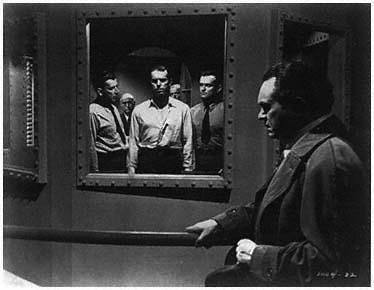Double Indemnity (lost alternate endings of film noir; 1944)
Double Indemnity is a 1944 film noir directed by Billy Wilder, co-starring Fred MacMurray as a likeable but cynical insurance salesman, Barbara Stanwyck as the femme fatale who convinces him to help murder her older husband for the payout, and Edward G. Robinson as the senior investigator of the insurance firm, who doesn't realize that in hounding Phyllis he's also closing in on his best friend. The film put Wilder's name on the map as an innovative director, and in the years since has not only set the standard but transcended its genre to earn a spot among the all-time cinema classics.
It is also notable for the amount of material that did not make it to screen. As it happened, Double Indemnity had two alternative endings: one of which was filmed, another which never made it past the scripting phase.
Alternative endings
A notorious perfectionist, Wilder had a reputation for ruthlessly removing/reshooting vital scenes even from final prints of his films if he felt they weren't working - notably redoing the entire opening of his masterpiece Sunset Boulevard, at the then-astronomical cost of $150,000, after preview audiences did not react as he wanted them to. In the case of Double Indemnity, he toyed both with an alternate ending and a significant extension of the one that was used.
The alternate ending was the one used in the original novel. The two main characters, Walter Neff and Phyllis Nirdlinger, flee the country after investigator Keyes makes it very clear that he knows they did it but will drop it on condition they disappear. They are onboard a steamship to Europe when Phyllis (who in the book is less seductive than flat-out psychotic) decides they must drown together. Several elements of this ending would have very obviously conflicted with the puritanical Hays Code imposed on fims at the time, and it was probably never intended to be filmed.[1]
By contrast, the extended end sequence was not only filmed but nearly included in the final print. In the canonical ending, a badly wounded Neff - who has been narrating the film in flashback from his office via a recorded confession to Keyes - is caught just as he concludes by the police, with Keyes in tow. Neff makes a last desperate run for it but can only stumble a few steps before collapsing. He and Keyes exchange a final, bittersweet goodbye, and we fade out there.
Originally, however, the film then cut to some time after Neff's arrest and presumably trial, as he is being led into and executed in a gas chamber while a heartbroken Keyes looks on from outside. Neff turns and locks eyes with him, just before the chamber door is closed. This sequence was shown to test audiences and was actually received quite well, but a Hays Code review deemed it "unduly gruesome"[1]. Wilder eventually decided it was altogether unnecessary, since the previous scene had already not only ended with Neff captured but neatly rounded off his and Keyes' complicated relationship, and hence the film.
Availability
The filmed sequence hasn't been seen since it was removed, shortly before the film's release. Efforts to find it have only served to confirm that the footage has been lost completely, apparently mishandled by Wilder's estate. A few production stills survive, along with a few versions of both scripts.
Video
Reference
- ↑ 1.0 1.1 A page of the book Wilder Times that mentions the two deleted scenes. Retrieved 04 Oct '19
